| Listing 1 - 10 of 30 | << page >> |
Sort by
|
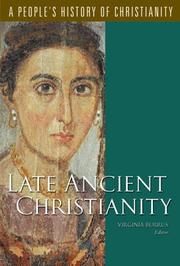
ISBN: 0800634128 9780800634124 Year: 2005 Volume: 2 Publisher: Minneapolis Fortress
Abstract | Keywords | Export | Availability | Bookmark
 Loading...
Loading...Choose an application
- Reference Manager
- EndNote
- RefWorks (Direct export to RefWorks)
Christian church history --- anno 500-599 --- anno 1-499 --- Christian life --- Church history --- History --- 27 "04/06" --- Kerkgeschiedenis--?"04/06" --- Apostolic Church --- Christianity --- Church, Apostolic --- Early Christianity --- Early church --- Primitive and early church --- Primitive Christianity --- Fathers of the church --- Great Apostasy (Mormon doctrine) --- Christian life - History - Early church, ca. 30-600 --- Church history - Primitive and early church, ca. 30-600 --- Histoire ecclésiastique
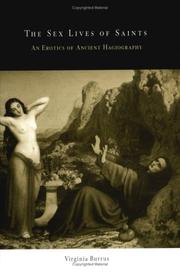
ISBN: 0812237455 9780812237450 Year: 2004 Publisher: Philadelphia (Pa.): University of Pennsylvania Press
Abstract | Keywords | Export | Availability | Bookmark
 Loading...
Loading...Choose an application
- Reference Manager
- EndNote
- RefWorks (Direct export to RefWorks)
Sex --- Christian hagiography --- Religious aspects --- Christianity --- History of doctrines --- History --- 235.3*14 --- -Sex --- -Gender (Sex) --- Human beings --- Human sexuality --- Sex (Gender) --- Sexual behavior --- Sexual practices --- Sexuality --- Sexology --- Hagiography, Christian --- Hagiography --- Hagiografie: martyrium --- -Religious aspects --- -Christianity --- -History --- History of doctrines. --- -Hagiografie: martyrium --- 235.3*14 Hagiografie: martyrium --- -235.3*14 Hagiografie: martyrium --- Gender (Sex) --- Religious aspects&delete& --- Christianity&delete& --- Sex - Religious aspects - Christianity - History of doctrines --- Christian hagiography - History - To 1500 --- Saints --- Sexualité
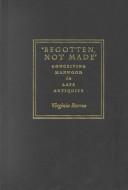
ISBN: 0804739730 0804737061 Year: 2000 Publisher: Stanford (Calif.): Stanford university press
Abstract | Keywords | Export | Availability | Bookmark
 Loading...
Loading...Choose an application
- Reference Manager
- EndNote
- RefWorks (Direct export to RefWorks)
Nicene trinitarian doctrine (when the Trinity became for the first time the centrepiece of doctrinal orthodoxy) is important not only for theological innovation but also for the redefinition of manhood in the fourth century. Exploring the significance of this movement for the subsequent history of Western masculine ideals, the author directly engages, combines, and disrupts divergent perspectives of historical theology, late Roman cultural history, and French feminist theory, bringing contemporary theorist Luce Irigaray into dialogue with the Patristic corpus. The book centers on performative readings of Athanasius of Alexandria, Gregory of Nyssa, and Ambrose of Milan, each of whom played a crucial role in defending Nicene trinitarian doctrine. Each also modelled a distinctive style of fourth-century masculine self-fashioning. The concluding chapter considers the sum of these three figures from an explicitly feminist theological and theoretical perspective.
233 --- De mens. Theologische antropologie --- Masculinity --- Men (Christian theology) --- Religious aspects --- Christianity. --- History of doctrines. --- Gregory, --- Ambrose, --- Athanasius, --- Nicene Creed. --- Theological anthropology --- Masculinity (Psychology) --- Sex (Psychology) --- Men --- Religious aspects&delete& --- Christianity --- History of doctrines --- Ghirīghūriyūs, --- Grégoire, --- Gregor, --- Gregori, --- Gregorio, --- Grēgorios, --- Gregorius, --- Grigoli, --- Grigoriĭ, --- Grzegorz, --- Qiddīs Ghirīghūriyūs Usquf Nīṣṣ, --- Afanasiĭ, --- Aḟanasīĭ Velikīĭ, --- Atanasio, --- Atanazy, --- Atanazy Wielki, --- Athanase, --- Athanasios, --- Athanāsiyūs, --- Athnāsiyūs, --- Bābā Athanāsiyūs Baṭriyark al-Iskandarīyah, --- أثناسيوس، --- بابا اثناسيوس بطريرك الإسكندرية --- Atanasie cel Mare, --- Pseudo-Athanasius --- Ambrogio, --- Ambroise, --- Ambrosio, --- Ambrosius Mediolanensis, --- Ambrosius, --- Ambrosius von Mailand, --- Amvrosīĭ, --- Aurelio Ambrogio, --- Aurelius Ambrosius, --- Niceno-Constantinopolitan Creed --- Symbolum Nicaenum --- Nicaenische Glaubensbekenntnis --- Nizänisches Glaubensbekenntnis --- Constantinopolitan Creed --- Credo des Conciles de Nicée-Constantinople --- Symbolum Constantinopolitanum --- Glaubensbekenntnis von Nizäa-Konstantinopel --- Nikaian-Konstantinopolin uskontunnustus --- NK --- Σύμβολον της Πίστεως --- Symvolon tēs Pisteōs --- Icon/Symbol of the Faith --- Profession of Faith of the 318 Fathers --- Profession of Faith of the 150 Fathers --- Credo (Nicene Creed) --- Grigorije, --- Афанасий, --- Gregorius Nyssenus --- Gregor von Nyssa --- Gregorio di Nissa --- Gregorius van Nyssa --- Gregory of Nyssa --- Grégoire de Nysse --- Atanasije Aleksandrijski, --- Athanasios Alexandreias, --- Ambrogio --- Ambroise --- Ambrose --- Ambrosio --- Ambrosius Mediolanensis --- Ambrosius --- Ambrosius von Mailand --- Amvrosīĭ --- Aurelio Ambrogio --- Aurelius Ambrosius
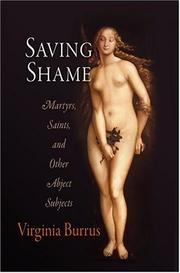
ISBN: 0812240448 1322510415 0812201515 9780812240443 9780812224276 Year: 2008 Publisher: Philadelphia, Pa University of Pennsylvania Press
Abstract | Keywords | Export | Availability | Bookmark
 Loading...
Loading...Choose an application
- Reference Manager
- EndNote
- RefWorks (Direct export to RefWorks)
Virginia Burrus explores one of the strongest and most disturbing aspects of the Christian tradition, its excessive preoccupation with shame. While Christianity has frequently been implicated in the conversion of ancient Mediterranean cultures from shame- to guilt-based and, thus, in the emergence of the modern West's emphasis on guilt, Burrus seeks to recuperate the importance of shame for Christian culture. Focusing on late antiquity, she explores a range of fascinating phenomena, from the flamboyant performances of martyrs to the imagined abjection of Christ, from the self-humiliating disciplines of ascetics to the intimate disclosures of Augustine. Burrus argues that Christianity innovated less by replacing shame with guilt than by embracing shame. Indeed, the ancient Christians sacrificed honor but laid claim to their own shame with great energy, at once intensifying and transforming it. Public spectacles of martyrdom became the most visible means through which vulnerability to shame was converted into a defiant witness of identity; this was also where the sacrificial death of the self exemplified by Christ's crucifixion was most explicitly appropriated by his followers. Shame showed a more private face as well, as Burrus demonstrates. The ambivalent lure of fleshly corruptibility was explored in the theological imaginary of incarnational Christology. It was further embodied in the transgressive disciplines of saints who plumbed the depths of humiliation. Eventually, with the advent of literary and monastic confessional practices, the shame of sin's inexhaustibility made itself heard in the revelations of testimonial discourse. In conversation with an eclectic constellation of theorists, Burrus interweaves her historical argument with theological, psychological, and ethical reflections. She proposes, finally, that early Christian texts may have much to teach us about the secrets of shame that lie at the heart of our capacity for humility, courage, and transformative love.
Shame --- Religious aspects --- Christianity. --- Honte --- Aspect religieux --- Christianisme --- Christian moral theology --- Christian church history --- History of civilization --- 241.4 --- 265.6 --- 265.6 Boetesacrament. Biecht --- Boetesacrament. Biecht --- 241.4 Theologische ethiek: schuld; zonde; bekering; verzoening --- Theologische ethiek: schuld; zonde; bekering; verzoening --- Humiliation. --- Emotions --- Ancient Studies. --- Cultural Studies. --- Literature. --- Religion.
Book
ISBN: 0520089979 0585160201 9780585160207 9780520089976 Year: 1995 Publisher: Berkeley University of California press
Abstract | Keywords | Export | Availability | Bookmark
 Loading...
Loading...Choose an application
- Reference Manager
- EndNote
- RefWorks (Direct export to RefWorks)
Silenced for 1,600 years, the "heretics" speak for themselves in this account of the Priscillianist controversy that began in fourth-century Spain. In a close examination of rediscovered texts, Virginia Burrus provides an unusual opportunity to explore heresy from the point of view of the followers of Priscillian and to reevaluate the reliability of the historical record. Her analysis takes into account the concepts of gender, authority, and public and private space that informed established religion's response to this early Christian movement.
273.22 --- Priscillianism --- Women in Christianity --- -#GOSA:II.P.PRIS.M --- 273.22 Priscillianisme --- Priscillianisme --- History --- -Priscillian Bishop of Avila --- Priscillianism. --- Priscillian, --- Prisciliano, --- Priscillianus, --- Heterodoxe stromingen. --- RELIGION --- History. --- Early church. --- 30-600. --- Spain. --- Spanje. --- Religion --- Philosophy & Religion --- Christianity --- Christian heresies --- #GOSA:II.P.PRIS.M
Book
ISBN: 0889465266 Year: 1987 Publisher: Lewiston Mellen
Abstract | Keywords | Export | Availability | Bookmark
 Loading...
Loading...Choose an application
- Reference Manager
- EndNote
- RefWorks (Direct export to RefWorks)
Apocryphal Acts of the Apostles --- Celibacy --- Women in Christianity --- Criticism, interpretation, etc. --- Christianity --- History of doctrines --- History --- 229*42 --- 229*42 Apocriefe handelingen der apostelen van Andreas, Barnabas, Philippus, Jacobus, Johannes, Matthaeus, Paulus, Petrus, Pilatus, Thomas, Paulus en Thecla, Petrus en Paulus --- Apocriefe handelingen der apostelen van Andreas, Barnabas, Philippus, Jacobus, Johannes, Matthaeus, Paulus, Petrus, Pilatus, Thomas, Paulus en Thecla, Petrus en Paulus --- Clerical celibacy --- Clergy --- Sexual abstinence --- Acts (Apocryphal books) --- Acts of the Apostles (Apocryphal books) --- Apocryphal books (New Testament) --- Criticism, interpretation, etc --- Religious aspects
Book
ISBN: 9780812250794 Year: 2019 Publisher: Philadelphia University of Pennsylvania Press
Abstract | Keywords | Export | Availability | Bookmark
 Loading...
Loading...Choose an application
- Reference Manager
- EndNote
- RefWorks (Direct export to RefWorks)
Christian hagiography --- Christian hagiography. --- Church history --- Cosmology, Ancient. --- Ecology --- Material culture --- History --- Primitive and early church. --- Religious aspects --- Christianity. --- Religious aspects. --- To 1500. --- Cosmology, Ancient --- 241.65*7 --- 213 --- 241.65*7 Theologische ethiek: natuur; ecologie --- Theologische ethiek: natuur; ecologie --- Ancient cosmology --- Apostolic Church --- Christianity --- Church, Apostolic --- Early Christianity --- Early church --- Primitive and early church --- Primitive Christianity --- Fathers of the church --- Great Apostasy (Mormon doctrine) --- Balance of nature --- Biology --- Bionomics --- Ecological processes --- Ecological science --- Ecological sciences --- Environment --- Environmental biology --- Oecology --- Environmental sciences --- Population biology --- 213 Creation du monde. Evolution. Emanation. Eternite du monde --- 213 Schepping. Emanatisme. Evolutionisme. Creationisme. Eeuwigheid van de wereld --- Creation du monde. Evolution. Emanation. Eternite du monde --- Schepping. Emanatisme. Evolutionisme. Creationisme. Eeuwigheid van de wereld --- Religious aspects&delete&
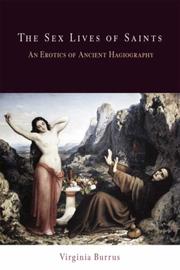
ISBN: 081222020X 9786613211194 128321119X 0812200721 Year: 2004 Publisher: Philadelphia, Pa. : University of Pennsylvania Press,
Abstract | Keywords | Export | Availability | Bookmark
 Loading...
Loading...Choose an application
- Reference Manager
- EndNote
- RefWorks (Direct export to RefWorks)
Has a repressive morality been the primary contribution of Christianity to the history of sexuality? The ascetic concerns that pervade ancient Christian texts would seem to support such a common assumption. Focusing on hagiographical literature, Virginia Burrus pursues a fresh path of interpretation, arguing that the early accounts of the lives of saints are not antierotic but rather convey a sublimely transgressive "countereroticism" that resists the marital, procreative ethic of sexuality found in other strands of Christian tradition.Without reducing the erotics of ancient hagiography to a single formula, The Sex Lives of Saints frames the broad historical, theological, and theoretical issues at stake in such a revisionist interpretation of ascetic eroticism, with particular reference to the work of Michel Foucault and Georges Bataille, David Halperin and Geoffrey Harpham, Leo Bersani and Jean Baudrillard. Burrus subsequently proceeds through close, performative readings of the earliest Lives of Saints, mostly dating to the late fourth and early fifth centuries-Jerome's Lives of Paul, Malchus, Hilarion, and Paula; Gregory of Nyssa's Life of Macrina; Augustine's portrait of Monica; Sulpicius Severus's Life of Martin; and the slightly later Lives of so-called harlot saints. Queer, s/m, and postcolonial theories are among the contemporary discourses that prove intriguingly resonant with an ancient art of "saintly" loving that remains, in Burrus's reading, promisingly mobile, diverse, and open-ended.
Sex --- Christian hagiography --- Gender (Sex) --- Human beings --- Human sexuality --- Sex (Gender) --- Sexual behavior --- Sexual practices --- Sexuality --- Sexology --- Religious aspects --- Christianity --- History of doctrines. --- History --- Ancient Studies. --- Gender Studies. --- Religion. --- Religious Studies. --- Women's Studies.

ISBN: 9780812220209 Year: 2008 Publisher: Philadelphia, Pa University of Pennsylvania Press
Abstract | Keywords | Export | Availability | Bookmark
 Loading...
Loading...Choose an application
- Reference Manager
- EndNote
- RefWorks (Direct export to RefWorks)
Christian dogmatics --- Christian church history --- sexuality --- saints --- hagiographies [works]
Book
ISBN: 9780812200720 Year: 2010 Publisher: Philadelphia
Abstract | Keywords | Export | Availability | Bookmark
 Loading...
Loading...Choose an application
- Reference Manager
- EndNote
- RefWorks (Direct export to RefWorks)
| Listing 1 - 10 of 30 | << page >> |
Sort by
|

 Search
Search Feedback
Feedback About UniCat
About UniCat  Help
Help News
News